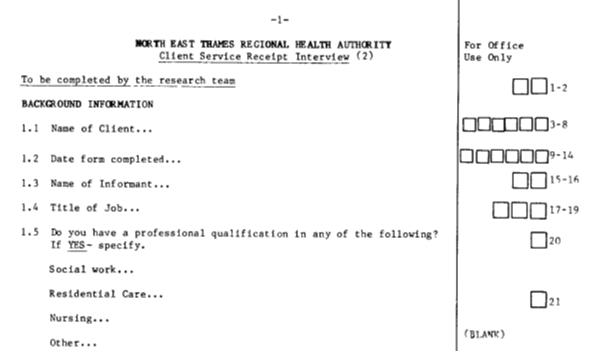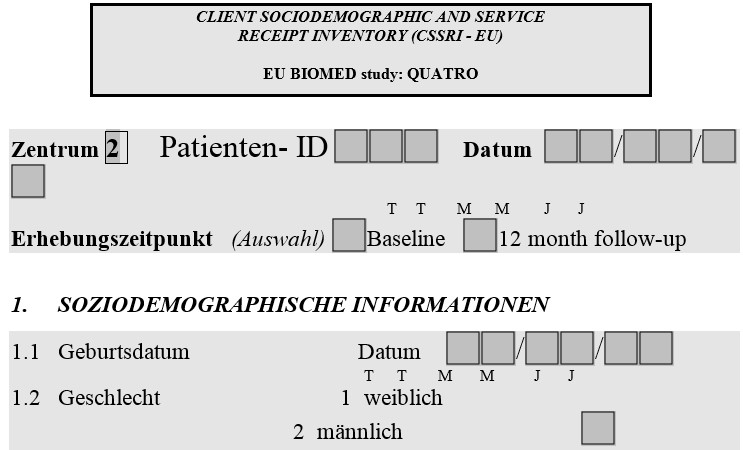May 11, 2016
By Jennifer Beecham, Professor of Health and Social Care Economics, PSSRU at the University of Kent and the London School of Economics
Some thirty years have passed since the very first Client Service Receipt Inventory (CSRI) was used, to capture a comprehensive picture of the way individuals used services and supports. The CSRI has always been freely available, although we always encourage researchers to tell us when they are using it. However, ten years or so have passed since we thought a website could showcase the CSRI and  make it more easily accessible!
make it more easily accessible!
Finding the starting point for the website was never the challenge.
The CSRI was first developed for two evaluations that focussed on deinstitutionalisation.
Moving residents from the old long stay hospitals was a major 1980s policy issue in the UK. Would community-based care generate good outcomes for people? Would it cost more? Would it be more cost-effective than the hospital care it replaced? The CSRI was developed to help explore such questions.
In all honesty, we have lost count of how many evaluations have used the CSRI since then, but we do know it must be at least 609; this is how often the main CSRI reference has been cited (Google Scholar; April 2016).
Versions of the CSRI have been used in evaluations of interventions and services for children, adults and older people. Versions have been developed for people with physical or mental health problems, intellectual disabilities, as well and a range of other long-term conditions.
It has been used in all countries of the UK, many in Europe, in the US, in Australia and New Zealand, and some African countries.
The real challenge was ensuring the website best illustrated the key principles underpinning the CSRI.
- Comprehensiveness: we use the concept of societal costs as our starting point. All inputs can be recorded, including those not attributable to formal treatment and care providers.
- Standardisation to support comparisons: the five domains include background participant information; accommodation and living situation; employment history, earnings and social security benefits; a record of service use; and support from unpaid (informal) sources, such as family carers.
- Flexibility: so that the CSRI is appropriate to the study’s service and user context, to the research questions, and to the way the information will be collected (eg. via face-to-face interview, postal survey etc.).
- And perhaps most importantly, that the information can be recorded in a way that allows accurate costs for ‘treatment and support packages’ to be estimated.
In the end, we uploaded versions of the CSRI that illustrated a range of policy and practice contexts, where we had a stand-alone electronic version (some CSRIs are embedded in a larger questionnaire), and where there is a report of the study and findings. Perhaps it is a slightly idiosyncratic selection, and certainly it is biased towards studies involving PSSRU. However, we would be delighted to include more versions of the CSRI: please send a copy of the CSRI you used and a journal article, or its weblink.
So, with massive thanks to Amritpal Rehill for gathering and organising all the information and here it is: this link allows you access to ‘ready-made’ CSRI examples as easy-to-edit Word documents, guidance to help you make the CSRI work for your study, information about its potential for analysis, and answers to FAQs.
But what of the future?
Well, there is no shortage of challenges to face, not least how the CSRI can be amended to best suit any particular project or set of research questions. We are continuing our work on ‘reduced list’ CSRIs. There are overarching content issues – e.g. how to elicit good quality information on personal budgets, direct payments, or unpaid care. And there are technical challenges. The CSRI has been successfully used as a face-to-face or telephone interview, as a (guided) self-complete schedule and in postal surveys. Currently we are designing an on-line CSRI to use in a multi-country European study. These developments will keep us going for a while so…
… Here’s to the CSRI’s next decade!
References:
Beecham, J. and Knapp, M. (2001) Costing psychiatric interventions, in G.Thornicroft (ed.) Measuring Mental Health Needs, Gaskell, 2nd edition, 200-224.
If you have any further questions or any of the links are broken then please contact us:
Professor Jennifer Beecham: j.k.beecham@kent.ac.uk

